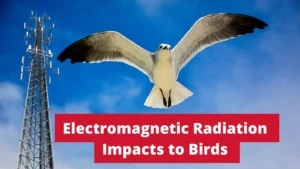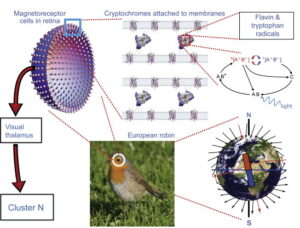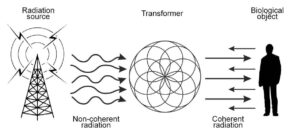In the last fifty years, the levels of nonionizing electromagnetic fields (EMF) in our environment have risen sharply, creating an omnipresent and continuous exposure that permeates even the most remote and rural areas. Unlike the visible pollutants we commonly think of, EMF is an invisible and biologically active form of environmental pollution that has been largely overlooked. However, its impact on the natural world is profound and increasingly concerning.
Many species of flora and fauna are sensitive to these ambient EMF levels, often more so than humans due to their unique physiologies and habitats. This heightened sensitivity can trigger complex biological reactions that are rarely seen but have significant consequences, potentially contributing to the decline and extinction of species. From disrupting orientation and migration patterns in birds to affecting the reproductive success of insects and mammals, the influence of EMF on wildlife is both varied and alarming.
Given the evidence from numerous studies showing the adverse effects of EMF on a wide range of species, it’s clear that this form of pollution poses a real threat to biodiversity. Despite these findings, EMF is not yet widely recognized as a pollutant, nor are there regulatory standards in place to mitigate its impact on wildlife.

This blog aims to shed some light on the hidden dangers of ambient EMF pollution, exploring its effects on different species and ecosystems. By understanding the scope and severity of EMF’s impact, we can begin to advocate for policy changes and protective measures to ensure the health and survival of our planet’s diverse inhabitants.
Understanding Nonionizing Electromagnetic Fields (EMF)
To grasp the significance of nonionizing electromagnetic fields (EMF) as an environmental pollutant, it is essential to understand what EMF is and how it differs from other types of radiation. Nonionizing EMF encompasses a range of electromagnetic waves, including extremely low frequency (ELF) fields, radiofrequency radiation (RFR), and microwave radiation. These fields are characterized by their inability to ionize atoms or molecules, which differentiates them from ionizing radiation such as X-rays and gamma rays that have enough energy to remove tightly bound electrons from atoms, leading to molecular changes.
The proliferation of EMF has come hand in hand with technological advancements and the widespread adoption of electronic devices. Over the past five decades,

ambient EMF levels have surged due to the increasing use of power lines, mobile phones, Wi-Fi networks, and other wireless communication systems. This rise has transformed EMF from a localized exposure in specific industrial settings to an incredibly ubiquitous presence that affects every corner of our environment.
Unlike other pollutants, we can’t see or touch EMF, making it challenging to see and measure the effects of it without specialized equipment. This invisibility creates an underestimation of EMF as a legitimate pollutant and a lack of awareness regarding its potential impacts. Despite being less understood and harder to detect, EMF has become a continuous and significant factor in our environmental landscape.
EMF Sensitivity in Wildlife
The impact of nonionizing electromagnetic fields extends far beyond human health, affecting a variety of wildlife species in profound and often underappreciated ways. Many animals possess unique physiological traits and inhabit environments that make them particularly sensitive to EMF. This sensitivity often surpasses that of humans, leading to more pronounced biological and behavioral effects.
Different species interact with their environments in ways that people don’t. For instance, many animals rely on Earth’s natural geomagnetic fields for navigation, migration, and other critical life functions. Birds, bees, and certain species of fish have specialized magnetoreception mechanisms that allow them to detect and respond to these geomagnetic cues. When these animals are exposed to anthropogenic (human-generated) EMF, their natural abilities can be disrupted, leading to disorientation and impaired survival behaviors.

Examples of Affected Species
- Birds: Many bird species use Earth’s magnetic fields for navigation during migration. Studies have shown that EMF exposure can disrupt their internal compasses, leading to navigation errors and increased mortality during migratory journeys.
- Insects: Bees, crucial for pollination and agricultural productivity, are highly sensitive to EMF. Exposure can impair their ability to find food, communicate within the hive, and reproduce, contributing to colony collapse disorder.
- Mammals: Species such as bats and deer exhibit disrupted feeding and reproductive behaviors when exposed to EMF. Marine mammals like whales and dolphins, which use echolocation and other sensory modalities to navigate and hunt, can also be adversely affected.
Complex Endogenous Reactions
The physiological responses to EMF in these animals are complex and can vary widely even within the same species. The reactions can include changes at the cellular level, such as altered gene expression and DNA damage, as well as broader behavioral changes that affect feeding, mating, and other survival activities. These responses are often subtle and cumulative, making them difficult to detect until significant harm has occurred.
Case Studies and Observations
Numerous field studies and laboratory experiments have documented these effects. For example, bats exposed to EMF show changes in their echolocation abilities, making it harder for them to navigate and hunt. Similarly, studies on amphibians like frogs have indicated developmental abnormalities and increased mortality rates in the presence of EMF.
The sensitivity of wildlife to EMF underscores the need for a more thorough examination of how these fields affect non-human species. By understanding these impacts, we can better assess the broader ecological consequences of EMF pollution and take steps to mitigate its harmful effects.
Biological and Behavioral Impacts of EMF on Flora and Fauna
The effects of EMF on wildlife are diverse and extensive, influencing various biological and behavioral aspects essential for survival. These impacts can be particularly detrimental due to the continuous and pervasive nature of EMF exposure in the environment.
Orientation and Migration
One of the most well-documented impacts of EMF is on the orientation and migration of animals. Birds, for instance, rely on the Earth’s magnetic field to navigate during long migratory journeys. EMF can interfere with their magnetic compass, causing disorientation and leading to migration errors. This disruption can result in birds flying off course, arriving at breeding or feeding grounds late, or even failing to complete their migrations, which directly affects their survival and reproductive success.
Food Finding and Foraging
Many species depend on their ability to detect and respond to subtle environmental cues to find food. Bees, which are vital for pollination, use magnetic fields to navigate and communicate with each other about the location of flowers. EMF exposure has been shown to impair these abilities, leading to decreased foraging efficiency and hive productivity. Similarly, bats use echolocation to hunt insects, and interference from EMF can disrupt their ability to accurately locate prey.
Reproduction and Mating
Reproductive behaviors and success are also affected by EMF. Insects, amphibians, and mammals have shown changes in mating behaviors, reduced fertility rates, and increased instances of birth defects when exposed to EMF. For example, studies have indicated that EMF exposure can alter hormone levels and reproductive cycles in mammals, affecting their ability to reproduce successfully.
Nest and Den Building
The construction of nests and dens is crucial for the protection and rearing of young in many species. Birds and small mammals exposed to EMF may experience disruptions in these behaviors, leading to poorly constructed nests or dens, which can increase vulnerability to predators and environmental stresses. In some cases, animals may even abandon their nests or dens due to EMF exposure.
Vitality, Longevity, and Survivorship
Overall vitality and longevity can be compromised by chronic EMF exposure. Laboratory studies on animal models have demonstrated cyto- and geno-toxic effects, including DNA damage, oxidative stress, and altered cellular functions. These effects can lead to reduced lifespans and decreased survivorship rates in the wild.
Regulatory and Policy Recommendations
Recognizing ambient EMF as a form of environmental pollution necessitates a paradigm shift in regulatory and policy frameworks. Current environmental laws and regulations do not adequately address the pervasive and continuous exposure to EMF that many wildlife species face. To safeguard ecosystems and biodiversity, it is imperative to develop and implement comprehensive policies that regulate EMF exposure.
Recognizing EMF as Pollution
The first step in mitigating the impacts of EMF on wildlife is to formally recognize EMF as a pollutant. This recognition would allow regulatory agencies to establish guidelines and standards for EMF exposure, similar to those for other environmental pollutants like chemicals and particulates. By designating air as a ‘habitat,’ regulators can set specific limits on EMF emissions to protect both human health and wildlife.
Setting Long-Term Chronic Low-Level EMF Exposure Standards
Current regulations, where they exist, often focus on short-term and high-intensity EMF exposure. However, wildlife is frequently subjected to long-term, low-level exposure that can have cumulative and chronic effects. It is essential to establish exposure standards that reflect these realities, taking into account the sensitivity of various species and their habitats. These standards should be based on the latest scientific research and updated regularly to incorporate new findings.

Implementing Protective Measures and Technologies
In addition to setting exposure standards, it is crucial to implement protective measures to minimize EMF pollution. This can include technological solutions such as shielding, similar to how Aires Tech is providing solutions for people, and better design of electronic devices and infrastructure to reduce EMF emissions. Urban planning and development guidelines should also incorporate considerations for minimizing EMF exposure, especially in areas critical for wildlife conservation.

Strengthening Environmental Laws and Enforcement
Existing environmental laws should be strengthened to include provisions for EMF regulation. This includes updating wildlife protection acts and habitat conservation laws to address the impacts of EMF. Effective enforcement mechanisms must be put in place to ensure compliance with these regulations.
Promoting Research and Public Awareness

Continued research is essential to understand the full scope of EMF’s impact on wildlife and to refine regulatory standards. Governments and scientific institutions should fund and support studies that explore the biological and ecological effects of EMF. Public awareness campaigns can also play a crucial role in educating the public and stakeholders about the risks of EMF and the importance of reducing exposure. By raising awareness, we can foster a culture of responsibility and action to protect the environment.
Collaborating Internationally
EMF pollution is a global issue that requires international collaboration. Countries should work together to harmonize EMF regulations and share research findings. International agreements and frameworks can help ensure that EMF pollution is addressed consistently and effectively worldwide, protecting migratory species and cross-border ecosystems.
Conclusion
The pervasive rise of nonionizing electromagnetic fields in our environment over the past five decades presents a significant and often underappreciated threat to wildlife and ecosystems. Many species exhibit heightened sensitivity to EMF, leading to a range of adverse biological and behavioral effects that can disrupt vital functions such as navigation, reproduction, and survival. These impacts underscore the urgent need to recognize EMF as a novel form of pollution and to implement robust regulatory measures to mitigate its effects.
By setting long-term chronic exposure standards, enhancing environmental laws, and promoting research and public awareness, we can begin to address the complex challenges posed by EMF pollution. Protecting wildlife from EMF requires a multifaceted approach that integrates scientific knowledge with proactive policy-making and international collaboration.
As we continue to advance technologically, we have to be sure also to prioritize the health of our planet’s ecosystems. Recognizing and addressing EMF pollution is a critical step toward ensuring a sustainable and biodiverse future. Let’s take action and do what we can to safeguard the natural world from the unseen but rapidly growing influence of electromagnetic fields.








